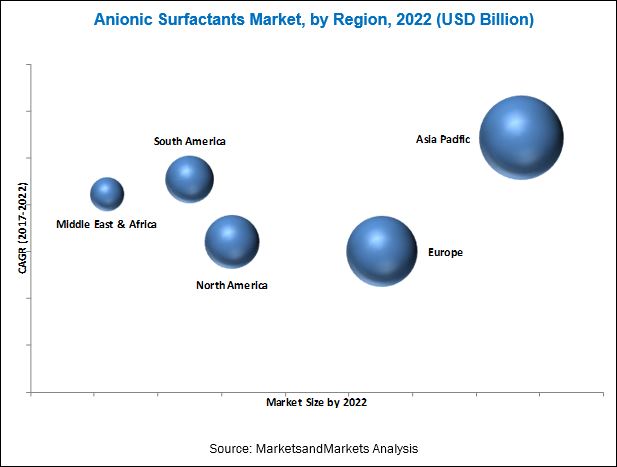Practices › Surfactants › Anionic Surfactants Market
Anionic Surfactants Market
The anionic surfactants market was estimated at USD 16.36 billion and is projected to reach USD 20.10 billion by 2022, at a CAGR of 4.2% from 2017 to 2022. The market is expected to witness high growth in several growing economies of Asia Pacific and the Middle East & Africa owing to the increasing spending power, growth in the infrastructure industry, and growth in the manufacture of detergents and cosmetics. Increasing population and rising consumption of personal care products are also contributing significantly to the growth of the anionic surfactants market in Asia Pacific.
The different types of anionic surfactants are linear alkylbenzene sulfonate, lignosulfonate, alcohol ether sulfates/fatty alcohol sulfates, alkyl sulfates/ether sulfates, sarcosinates, alpha olefin sulfonates, phosphate esters, alkyl naphthalene sulfonates, and others. The anionic surfactants market is expected to grow at a steady rate during the forecast period. This is due to their wider application range, easy availability, and lower cost than other surfactants. Anionic surfactants are widely used in cleaning and related products such as detergents, soaps, cleaners, shampoos, and hand washes. These are among the largest application areas of surfactants due to which the anionic surfactants account for the majority share of the overall surfactants market.
Asia Pacific was the largest market for anionic surfactants in 2017, globally. High consumption potential, growing production capacities, competitive manufacturing costs, and high economic growth are the major driving forces for the market in the region. This dominance of Asia Pacific is mainly due to the increasing population and improving lifestyles at each financial stratum. The demand for anionic surfactants is dependent on their use in industries such as soaps & detergents and personal care products which contribute to more than 50% of its global demand. Companies are investing more on R&D to find out applications of surfactants in unconventional industry segments (petroleum industry, textile industry, paper & pulp industry, healthcare industry, and others) to increase their scope and demand. The anionic surfactants market in the Middle East & Africa is projected to register the highest growth. The factors contributing to this are the increase in the demand from the developing countries because of the increased industrialization. In the Middle East, the oil & gas industry is expected to continue to grow owing to the presence of vast reserves of crude oil and development of technologies for enhanced oil recovery. The industry will witness growth because of significant investments in re-exploring oil & gas and exploring new reserves.

Home care, personal care, and oil & gas applications to drive the growth of anionic surfactants market
Home care
Anionic surfactants are used in home care applications such as laundry detergents, dishwasher detergents, carpet cleaners, floor cleaners, and various types of fabric softeners. Anionic surfactants in detergents help remove oil, dirt, and unwanted particles from fabrics, dishes, and other surfaces. They not only remove the dirt and unwanted particles but also keep them suspended during washing, resulting in a cleaner surface. Anionic surfactants are mainly used in the soap & detergents industry due to their surface tension reduction and wettability properties.
Personal care
Anionic surfactants, when added to a liquid, reduces the surface tension. The reduction in surface tension enhances the spreading and wetting properties. Anionic surfactants are responsible for antimicrobial properties, foaming and conditioning properties (in the case of shampoos, face washes, and skin care creams), mild detergency actions, and preservative properties that are essential in the personal care industry. They also act as cleansing agents, emulsifiers, foaming agents, solubilizers, and wetting agents and hence are mainly used in make-up, skin care, hair care, oral care, and other personal care products.
Oil & Gas
The global oil & gas industry uses different specialty chemicals, including anionic surfactants, to produce oil, natural gas, and coal bed methane. The EOR technique extensively uses anionic surfactants that lead to additional oil recovery. The other applications of anionic surfactants in the oil & gas industry are well stimulation, drilling/completion, production/refining, and pipeline transport. In the oil & gas industry, anionic surfactants can be used for different purposes as emulsifiers, dispersants, corrosion inhibitors, foam controlling agents, wetting agents, suspending agents, and biocides. Major oilfield surfactants are sulfates, sulfonates, and lignosulfonates.
Critical questions the report answers:
- Where will all these developments take the industry in the mid to long term?
- What are the upcoming product type of anionic surfactants?
To speak to our analyst for a discussion on the above findings, click Speak to Analyst
The increasing awareness regarding personal health has propelled the need for personal care products. This change has led to an increased manufacturing of skin care and hair care products, thus driving the demand for anionic surfactants in the personal care market. A major change in lifestyle of consumers is witnessed in most of the developing countries, especially China and India. The development is backed by their increasing income and purchasing power. These factors have increased the demand for anionic surfactants in the personal care application in these countries.
The companies profiled in this report are AkzoNobel (Netherlands), BASF (Germany), Clariant (Switzerland), DowDuPont (US), Evonik (Germany), Croda International (US), Stepan Company (US), Huntsman (US), Kao Corporation (Japan), and Galaxy Surfactants (India), among others.
